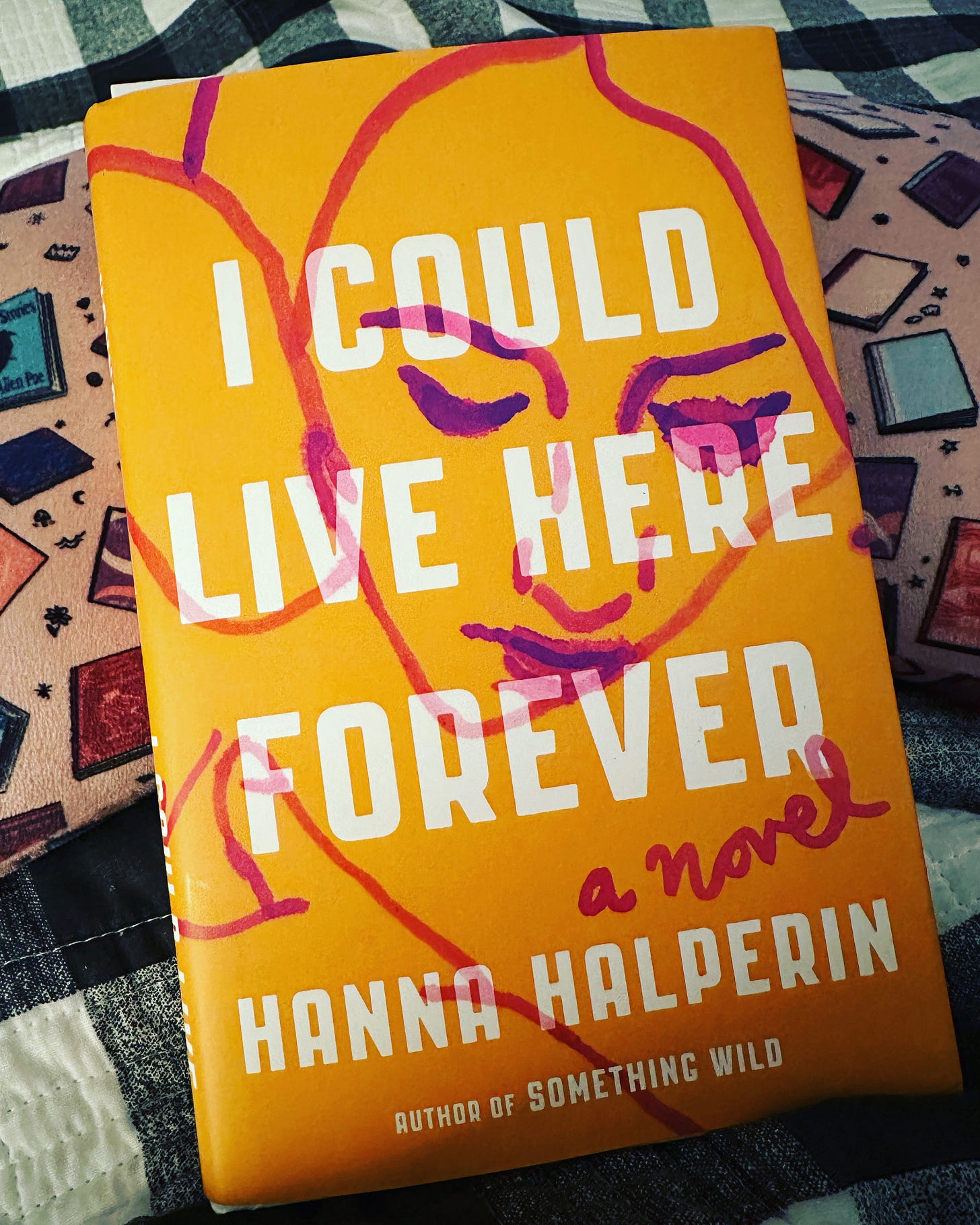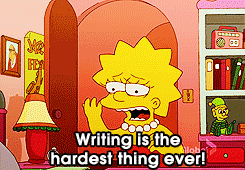If you’re new here (hi!), I’m doing a series this summer where I am reading books “like a writer”—analyzing, underlining, taking notes, etc.—so that we can learn and deepen our own writing craft.
Today is the first post in the series, and I’ll be talking about the gorgeous literary novel I Could Live Here Forever by Hanna Hamperin.
First, here’s the back cover:
When Leah Kempler meets Charlie Nelson in line at the grocery store, their attraction is immediate and intense. Charlie, with his big feelings and grand proclamations of love, captivates her completely. But there are peculiarities of his life—he’s older than her but lives with his parents; he meets up with a friend at odd hours of the night; he sleeps a lot and always seems to be coming down with something. He confesses that he’s a recovering heroin addict, but he promises Leah that he’s never going to use again.
Leah's friends and family are concerned. As she finds herself getting deeper into an isolated relationship, one of manipulation and denial, the truth about Charlie feels as blurry as their time together. Even when Charlie’s behavior becomes increasingly erratic, when he starts to make Leah feel unsafe, she can’t help but feel that what exists between them is destined. Charlie is wide open, boyish, and unbearably handsome. The bounds of Leah’s own pain—and love—are so deep that she can’t see him spiraling into self-destruction.
Hanna Halperin writes with aching vulnerability and intimacy, sharply attuned to Leah’s desire for an all-consuming, compulsive connection. I Could Live Here Forever exposes the chasm between perception and truth to tell an intoxicating story of one woman’s relationship with an addict, the accompanying swirl of compassion and codependence, and her enduring search for love and wholeness.
Initial Thoughts
I write happily ever afters, but sometimes I want to read stories about love that didn’t get wrapped up with a bow. Love is complicated, and I like reading all the different iterations of it.
However, I don’t like when I feel like a story is just trying to manipulate me into crying. This didn’t feel like that at all. This felt realistic and (at times) romantic and (at times) terribly sad and (at times) hopeful and (at times) tragic. Which, as we know, is how life is.
So, reading this story as a writer, what I appreciated most was that the author created characters who felt like actual people not book characters.
I highly recommend it as a read if you can handle this type of book (check triggers.) But even if you don’t get a chance to read it, what can we learn from it as writers?
Read this for…
Nuanced characterization
I’m a character-driven writer, so great characterization is the number one thing I seek out in books, and this novel did this at a master level.
The key—nuance. We talk about writing flawed characters, but sometimes writers take this to mean their characters have one MAJOR FLAW and ONE MAJOR TRAUMA for why they are the way they are. We fill in the blanks on that writing worksheet we got in that workshop that one time. Flaw? Check! Backstory trauma? Check! But that’s not real life or real people.
Real people have good things about them, bad things about them, inconsistent things about them. So, when you write characters that way, they feel more real.
Leah, the lead character in this book, is smart and independent. She’s overcome some things. She has friends and dreams. But she also has a vulnerability. She’s never felt unconditionally loved and special (there’s a backstory reason.) So when she gets into a relationship with Charlie, who is very demonstrative and verbal about how he feels about her and who tells her how wonderfully special she is, she’s swept up in that—even when she starts getting signs that Charlie has some personal demons he’s fighting.
Now, Charlie, on the other hand, could’ve been portrayed as the villain, as an addict who takes advantage of an open-hearted woman, but that’s not how he’s presented. He’s sympathetic but also frustrating. He sometimes treats the heroine badly and uses her. But his love for her also feels genuine. Sometimes his behavior is sweet, sometimes it’s concerning. For someone who is battling an addiction, that seems very realistic. (The villain is actually the addictive nature of the drug.)
As a reader, I both simultaneously wanted the heroine to run and for her to help him. That’s good writing—to get me as the reader to feel that kind of inner conflict.
I also appreciated that side characters and family members were treated with this kind of nuanced characterization. I won’t get into details because of spoilers, but the lesson here is—don’t paint your side characters with generic brush strokes. They need to feel like real people too.
Beautiful literary writing
What makes something literary is the amount of attention paid to the prose all the way down to the sentence level.
For instance, the heroine’s mom took off and abandoned the family when the heroine was young. For anyone who has experienced grief, this line will ring true.
“Losing her has never stopped.” —pg. 84
It’s a simple sentence but whew, it says so much. We don’t lose people one time. Once they’re gone from our lives, whether they are still alive or not, the effect is now a part of us and will surface over and over again. Here’s the rest of the paragraph…
“While her disappearance happened fast, overnight—it’s been a slow endless transformation of our lives.” —pg. 84
Good writing touches on things that are universal, feelings that the reader can go, “Oh, wow, I feel that but never thought to put it that way.” That’s magic.
The use of metaphor
In addition to sentence-level stuff, literary writing uses metaphor and symbolism to deepen the writing.
One of my favorite examples in this book is how the heroine’s apartment is presented. Here’s how she describes it in the beginning:
“Nothing matched. But it was the first time I’d lived alone, and I loved everything about my apartment. It had a working fireplace and built-in bookshelves and French doors that led into a tiny study with windows that overlooked a courtyard. Each time I walked through my front door I felt peaceful—like this was where I was supposed to be.
I felt untethered and alive in Madison in a way that I never had in Boston. I don’t know if things were actually so different in Wisconsin, or if it was because I was away from my family and everything I’d ever known, but I woke up each morning with a feeling that finally my life was happening.” - pg. 26
I loved this description because it so perfectly encapsulates that feeling when you’re first on your own, but then, throughout the story, her apartment and the state of it plays a role.
I don’t want to spoil anything specific, but as things start to spiral in her relationship with Charlie, the apartment and the condition of it changes. I took it as a metaphor.
Even if a reader doesn’t actively recognize that this is the purpose it’s serving, it’s going to resonate on some subconscious level and deepen the reading experience.
And if that’s not enough, here are some other things you’ll get from this book…
Complicated love story
Love is messy and sometimes…love isn’t enough. (Which pains me to say as a romance writer! But it’s true.)
Lovely friend group
The way Leah’s MFA friends were described was lovely. Subtle characterization but effective. They try to intervene on her behalf but also give her space, much like real-life friends would do.
College coming-of-age
I think that the time between high school and adulthood is so rich with growth and experience, so it’s ripe for story. This was a well-done portrayal of a woman learning about herself as she grew into adulthood.
Portrayal of addiction and co-dependency
This could’ve been one note or heavy-handed, but I thought it was handled deftly.
Character Arcs
Writers are taught that characters go through an arc in a book. If the character changes and overcomes their flaw, it’s a happy ending. If they don’t change or can’t overcome it, it’s often a tragedy. This book lets you study that.
Final thoughts
I love a book about writers, and these two quotes (that I underlined—in pencil of course!) had me smiling.
“We were ‘writing friends,’ though, which I learned was a particular sort of friendship.” - pg. 27
“We took ourselves so seriously that the poets stopped hanging out with us.” —pg. 27
Hope you enjoyed this first analysis! Let me know in the comments if you found this helpful or if there is something you’d like to see added to these posts.
Have a great weekend!
Roni
Know someone who might find this newsletter helpful? I’d love it if you’d share this post!
*Book links are affiliate links (Amazon, Libro.fm, and/or Bookshop.org), which means I earn a small commission if you buy through my links. Also, I receive advanced listening copies of some audiobooks through Libro.fm’s Influencer program. However, all reviews and opinions are my own.







Now I want to rush out and get this book!
you just gave me an idea for the plot of my MS. Thank you.